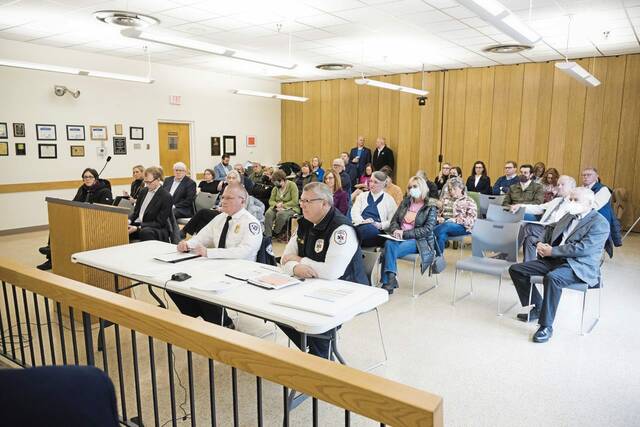https://mirror.triblive.com/local/mccandless-public-hearing-explores-shortages-needs-in-health-care/
McCandless public hearing explores shortages, needs in health care

Health care workers told lawmakers about staffing shortages and employee burnout that are creating critical needs, especially for nurses, in area hospitals.
Legislators from across the state attended a public hearing about the health care staffing crisis on Jan. 26 at the McCandless Town Hall, hosted by the newly elected State Rep. Arvind Venkat, D-McCandless, who represents District 30. Venkat also is an emergency room physician.
Nurses, paramedics, and hospital administrators testified. Venkat recalled his own experiences as a doctor, and said staff shortages were a “common story” for many communities.
“The time to say this is a problem is over. The time to address the health care situation is here. We must take action,” Venkat said.
Dr. Donald Yealy, senior vice president and chief medical officer for the University of Pittsburgh Medical Center, and Susan Hoolahan, a former nurse and current president for UPMC Passavant and Cranberry, discussed shortages they’ve experienced at their facilities.
Yealy said by 2026, Pennsylvania will face a deficit of 20,000 nurses. He said this is due to an aging workforce, not enough nurse educators and more patients. Nurses often see verbal or physical threats by patients, Hoolahan said.
Some nurses leave the profession for other jobs, calling the situation a “leaky bucket.” Yealy said nursing as a career needs to be encouraged in middle and high schools.
Also needed are more nurse educators.
Hoolahan, who lives in the North Hills, was a nurse for 40-plus years. Mandated staffing ratios need to be re-examined, she said.
“Staffing isn’t ‘one size fits all’,” she said, adding hospitals need staffing flexibility based on numerous factors, not ratios.
For example, allowing shifts in an emergency room based on need can open up a staff member to move to a busier area.
Yealy said though UPMC hired 34,000 employees last year, it still has 12,000 open positions, including 3,000 nursing positions. In order to attract and retain, UPMC is committed to minimum starting salaries for all non-union, entry-level positions at $18 an hour by 2025 for the Pittsburgh region. The minimum pay rate is for other full-time positions, with tuition reimbursement and other perks.
Michelle Boyle, a registered nurse for 28 years and a nurse member coordinator for the Nurse Alliance Service Employees International Union, called staffing levels a “crisis” and said nurses expect “stress” but there’s simply not enough staff for adequate care. She said there should be a safe patient level ratio.
“Unsafe staffing puts all lives at risk,” Boyle said. “(Patients) deserve dignity, they deserve respect, they deserve the care.”
She said young nurses are telling her they are anxious about being a bedside nurse because they “can’t be responsible for somebody’s death.”
Margaret DiCuccio, chief of nursing officer at Allegheny General Hospital — Allegheny Health Network, said many nurses are resorting to virtual nursing care. And the network is losing a lot of bedside nurses who become advanced skilled nurses, such as nurse practitioners.
AGH in 2022 had approximately 767 open bedside registered nurse positions to fill. That is a vacancy rate of 42 percent, she said. Frontline nurses are experiencing burnout, she said. Officials do not want to depend on travel nurses who temporarily help hospital staffing. These positions are expensive.
“We need to have more nurses in the pipeline. Every year of delays we have more and more issues,” DiCuccio said.
Christopher Dell, chief of the McCandless Franklin Park Ambulance Authority, and Eric Schmidt, chief of Shaler Hampton EMS and a chair of Allegheny County EMS Chiefs, both said staffing shortages were major problems in their industry.
When there’s not enough people working on shifts, calls get forwarded to another EMS company which is likely experiencing the same thing, said Dell.
Dell said grants and scholarships can help make EMS training more accessible and attractive. The approximate cost to go through an EMS program is $7,000, he said.
Schmidt called for a local or state funding mechanism. While EMS companies rely on billing insurance companies for calls, not all calls are billable. Many calls are for non-emergency situations, and if a call doesn’t end up in transport, the service doesn’t get paid.
He noted fuel costs have doubled, as has the need for more supplies such as personal protective equipment for every call. Technology for EMS medical care has gotten better, but more expensive.
Schmidt said reimbursements from insurance companies are not always enough.
“The days of EMS being provided at no cost to the communities that we serve must be behind us,” Schmidt said.
Venkat said these issues are something that “we can no longer ignore.”
Copyright ©2025— Trib Total Media, LLC (TribLIVE.com)
